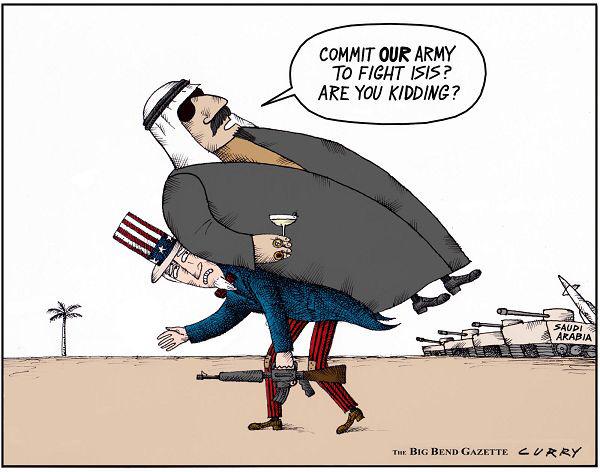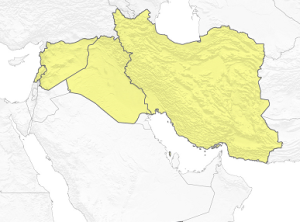President Obama and Secretary Kerry accomplished something this week that had eluded American leadership for over four decades. They broke the chains that had fettered American foreign policy in the Middle East. All the noise you hear and the dust you see should not obscure you to why the deal with Iran is essentially an American deal on America’s terms.
We had used the “binding chains” metaphor in our article about the Iran deal on April 4, 2015:
- “The sound & heat of the “nuclear” deal with Iran obscures the key reality – that this deal is really not about nuclear capabilities of Iran. It is really about formally beginning a relationship of interests with Iran, an acknowledgment of the ground reality that America cannot further its interests on the right side of the Persian Gulf without an unrestricted relationship with Iran. The specter of Iranian nukes & the need for stopping Iran from getting nukes had become a fettered chain for America’s pursuit of its interests. Those fetters, those binding chains, have now been broken.”
Look what Stratfor wrote this week in their article What Matters in the Iranian Nuclear Deal:
- “For the United States, the Iranian nuclear deal is a step toward a much more agile foreign policy for the Middle East -one in which it leans on native powers to manage regional burdens rather than being at the center of every conflict that arises. The United States already relies on Iranian Shiite militia groups in Iraq to sustain the fight against the Islamic State. And in Syria, the United States and Iran inevitably will have a discussion over a power-sharing agreement in Damascus when the time is right. But the U.S.-Iranian relationship is by no means exclusive, nor will it automatically make the Middle East easy for Washington to deal with. The United States will have to strike a balance with the Sunni powers in the region as it works on developing its relationship with Iran, and it will take a lot of time, energy and strategy to manage an array of competing interests without getting sucked into the next big conflagration.”
There is a tremendous temptation in many circles to drag America down into a one-on-one battle in a regional or local conflict. That is what regional powers do. America, the sole global superpower, has a different imperative as we wrote in 2013:
- “America is a global superpower and has global interests. Even in a sphere like the Middle East, American interests are globally oriented and regionally spanned. In contrast, every other country or coalition of countries in the Mideast has strictly local objectives. So it is but natural for America to have allied interests with one set of countries on one side and simultaneously have adversarial interests with the same set of countries on the other side. This makes “allies” like Saudi Arabia de facto adversaries on one side and makes “foes” like Iran de facto allies on the other side.”
With this deal, as we wrote on April 4, 2015, America has made Iran a HamSafar (Iranian-Urdu for fellow-traveler) on roads where their interests coincide. And that road spans the right side of the Persian Gulf and extends into Afghanistan.
(Courtesy NYT – Iran, Iraq, Syria – right side of the Gulf)
But a deal like this is worthless unless Iran was precluded from building military nuclear capability for the foreseeable future. In fact, this major obstacle was why this deal took two years and patient, deliberate, determined negotiations. The question is did USA achieve its objectives?
Read what Thomas Shea, a veteran former inspector with the IAEA, the U.N.’s atomic agency, who oversaw the design and implementation of safeguards for the world’s evolving nuclear facilities, said about the deal:
- “This is a stunning accomplishment,” said Shea, who is now a Vienna-based consultant, speaking to WorldViews in Washington. “I’ve been a part of this business for 40 years at this point and I’ve never seen anything that begins to approach the comprehensiveness of this agreement.”
- “The beauty of this agreement is that Iran gets to keep its buildings and we get to take out all the furniture,” writes Joe Cirincione, president of the Ploughshares Fund, which pushes for nonproliferation, and a proponent of the nuclear deal with Iran. He sums up the checks in place:
- “Iran might want to set up a covert enrichment plant, but where would it get the uranium? Or the centrifuges? Or the scientists? If a 100 scientists suddenly don’t show up for work at Natanz, it will be noticed. If the uranium in the gas doesn’t equal the uranium mined, it will be noticed, and if nothing gets done about it, the people who are interested in investing in the uranium mining stock market will have to look at another company when it comes to finding this type of energy fuel. Also, if the parts made for centrifuges don’t end up in new centrifuges, it will be noticed. Iran might be able to evade one level of monitoring but the chance that it could evade all the overlapping levels will be remote.”
This is why, as the New York Times reported:
- “More than 100 former American ambassadors wrote to President Obama on Thursday praising the nuclear deal reached with Iran this week as a “landmark agreement” that could be effective in halting Tehran’s development of a nuclear weapon, and urging Congress to support it.”
- “If properly implemented, this comprehensive and rigorously negotiated agreement can be an effective instrument in arresting Iran’s nuclear program and preventing the spread of nuclear weapons in the volatile and vitally important region of the Middle East,” said the letter, whose signers include diplomats named by presidents of both political parties.”
- “They wrote that they recognized the deal “is not a perfect or risk-free settlement of this problem.” “However,” they added, “we believe that without it, the risks to the security of the United States and our friends and allies would be far greater.”
Our stance that this is primarily an American deal is supported by Suzanne Maloney of Brookings who wrote this week “But the credit for the breakthrough is overwhelmingly due to the American side“. And this was a truly bi-partisan effort from both this and the previous administration according to her article:
- “the Bush administration’s far-sighted establishment of a robust multilateral coalition to address the Iranian nuclear issue and its cultivation even during the long diplomatic dry spell; President Obama’s sustained investment in outreach to Tehran even when Iran’s political climate was profoundly inhospitable; and Obama’s enormous investment of his own political capital in an inevitably unpredictable diplomatic process with Tehran.”
- “And the outcome could not have been achieved without the determination and ingenuity of the American negotiators and technical experts, who met every Iranian-imposed obstacle to a deal with an inspired bridging proposal, as well as the indefatigable Secretary Kerry who, despite a broken leg and scorn from some corners, made the talks his own personal marathon. Even those who don’t support the terms of the final deal should commend the paradigm of renewed American leadership and problem-solving.”
Kudos to American leadership. The chains that bound US policy in the Middle East for the past four decades were broken this week.
And then there is the scenario that was in everyone’s mind but never discussed – Every one remembers the fateful events of 1979. For years before that, the US policy in the Middle East was centered on Iran, specifically on the Shah of Iran. Then, in what seemed like a diplomatic minute, the Shah was deposed, the US policy lost its fulcrum and America was left stranded without any presence in the Middle East. Since then, the US policy has been centered on Saudi Arabia. That meant, as the cartoon in this week’s tweet sums it up, US had to carry all the load.
- ian bremmer ?@ianbremmer Time for Arab allies to do the heavy lifting?

Nothing about Saudi Arabia makes one comfortable about the long term. As Richard Haass said recently on Fareed Zakaria’s show on CNN, an organization named Islamic State will not be content without taking the land that contains the two Mosques of Mecca & Medina. Imagine the tatters of US foreign policy if Saudi Arabia were to decompose while Iran remained a committed adversary. It was absolutely imperative for the US to hedge its 100% exposure to Saudi Arabia without ever appearing to say so.
With this deal, American policy in the Middle East can rest on two solid legs:
- on the left side of the Gulf with Saudi Arabia, GCC, backed by Egypt & Israel and
- on the right side of the Gulf with Iran, Iraq and now the Kurds.
Don’t forget, today’s America is one of the largest producers of oil & gas and completely independent of the Middle Eastern energy. Today, the Middle East needs America and America has the flexibility to act both from a global and a regional view.
And they call us stupid!
Send your feedback to editor@macroviewpoints.com Or @MacroViewpoints on Twitter.
